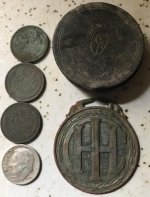DiggityDiggity
Full Member
- Sep 25, 2013
- 249
- 544
- Detector(s) used
- Garret AT Pro, Garrett 350
- Primary Interest:
- All Treasure Hunting
So when I detect beaches my 350 seems to go haywire over sand. It's very tough to hone in on a signal. When I do finally lock a signal, I'll dig the hole and find nothing there. This happens so frequently that I've almost given up on sand and stay with the grassy areas of the beach. I've put my sensitivity on multiple levels and still I'm having the same problem. Am I doing something wrong? Is this a common problem with 350's and/or detectors in general?



 Cheers!
Cheers!




